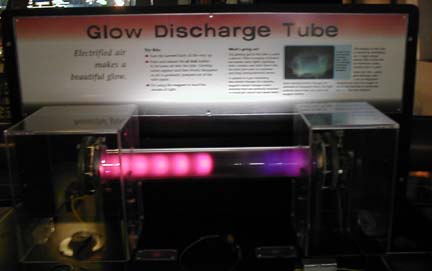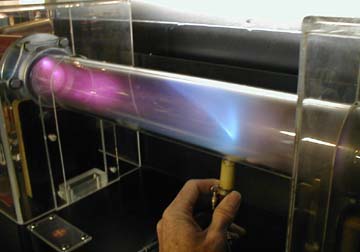An electron beam can be seen when it collides with air or glass.

Glow discharge tube at the Exploratorium.
An electron beam can be seen when it collides with air or glass.

Glow discharge tube at the Exploratorium.
To Do and Notice
Look at the glowing tube in the photo above.
The tube had been initially filled with air. The air is pumped out reducing the pressure. At low pressures read on a gauge, a glow appears in the tube.
Notice the violet glow near the right hand electrode which is labeled -, negative.
Notice the orange bands near the positive
electrode.
The graphics say that there is a 15,000 volt potential difference
between the electrodes.

As the pressure drops and the orange glow of the
nitrogen begins to fade, move a magnet underneath the electron beam.
The beam will bend to the side, collide with the glass wall of the
tube, and cause the glass to glow blue.
What's Going On?
Electrons are accelerated by the 15,000 volt difference between the metal electrodes at the ends of the tube.
When the electrons collide with molecules in the tube, mostly nitrogen, those molecules are excited and then when they drop back to lower energy states the molecules emit light. Nitrogen emits a pale orange light.
When the electrons collide with the glass, impurities in the glass cause it to fluoresce blue.
Moving electrons are bent to the side by magnetic
fields.
This side ward force is called the Lorentz force.
See the math root below for more details.
I've never heard a good explanation for why there are glowing bands separated by dark regions.
So What?
In a particle accelerator the charged particles are accelerated at first by a voltage difference
When the electrons gain higher energies than those in our exhibit, they ionize atoms. At higher energies still they can collide with particles in the nucleus.
In an accelerator, the tube through which the electrons travel is kept at high vacuum to prevent the beam from colliding with stray molecules.
Magnets are used in accelerators to deflect the beam of electrons or other charged particles.
Math Root
Right Hand Rule
The magnetic force on a moving charged particle can be found using the right hand rule.
Place the fingers of your right hand pointing in the direction of the magnetic field, i.e. out of the north pole or into the south pole of a magnet.
Point your thumb in the direction of motion of the charged particle.
Your palm will then push in the direction of the magnetic force on a positive particle.
Negative particles move the opposite way.
For example above:
The magnet has it's south pole up near the glass so that the fingers of the right hand point down, into the south pole.
The particles move to the left so the thumb points left.
The particles are negatively charged so they are forced away from the front and toward the back. Notice the pattern of glowing glass is bent toward the back.
|
Scientific Explorations with Paul Doherty |
|
8 November 2000 |